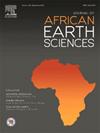晚白垩世-古新世构造事件对特提斯南部边缘演化的极端影响:以埃及东部沙漠为例
IF 2.2
4区 地球科学
Q2 GEOSCIENCES, MULTIDISCIPLINARY
引用次数: 0
摘要
埃及地区分布良好的晚白垩世-早古近纪岩石是了解特提斯南部地质历史的关键之一。研究了伊什-埃尔梅拉哈地区暴露的4套晚白垩世-早古近纪序列。综合地层分析包括:这些剖面的岩石地层学和生物地层学都显示出有趣的结果。贯穿古新世的强烈构造作用对所有岩石单元都产生了重大影响,造成了它们的相和厚度的差异。此外,这些构造作用还使沉积盆地发生变形。在古新世,伊什-埃尔梅拉哈地区经历了与叙利亚弧构造事件相关的两次重要的同沉积构造事件(ⅰ和ⅱ)。伊什-埃尔梅拉哈盆地的演化在这一时期首次被记录下来,这一时期极其依赖于这些构造事件。研究人员创建了四个古地形剖面,以说明这些事件如何影响沉积盆地的历史,从北Wadi Qena向北延伸到Gabal Hamadat向南。构造事件的强度导致伊什-埃尔梅拉哈地区经历了不同程度的不稳定。这些剖面显示了马斯特里赫特时期沉积的稳定性。然而,在大年期间,盆地经历了自北向南扩展的薄层沉积。这使得盆地抬升为海底古隆起,形成了侵蚀面。在晚古新世(Selandian-Thanetian),盆地南部(Hamadat)比北部(north Wadi Qena)更深。与此相反,伊什-埃尔梅拉哈地区的盆地成为一个空中古隆起,这一事件始于大年纪末,一直持续到早始新世(伊波斯纪)。这种隆起导致了重要古土壤层的形成。此外,伊什-埃尔梅拉哈沉积中心的南段构造作用较小,而伊什-埃尔梅拉哈沉积中心的北段构造活动剧烈。本文章由计算机程序翻译,如有差异,请以英文原文为准。
Extreme impact of the Late Cretaceous–Paleocene tectonic events on the evolution of the southern Tethyan margin: a case study from Eastern Desert, Egypt
The well-distributed Late Cretaceous–early Paleogene rocks in Egypt are one of the keys to understanding the geologic history of the southern Tethys. Four Late Cretaceous–early Paleogene successions exposed in the Esh-ElMellaha area were investigated. The integrated stratigraphic analyses, including; field, lithostratigraphy and biostratigraphy of these sections within the Esh-ElMellaha ridge showed interesting results. Intensive tectonic processes throughout Paleocene period substantially influenced all rock units, causing differences in their facies and thickness. In addition, these tectonic processes deformed the sedimentary basins. During the Paleocene, Esh-ElMellaha area experienced two significant syn-sedimentary tectonic events (I and II) related to the Syrian Arc Tectonic Event. The evolution of the Esh-ElMellaha basin has been documented for the first time throughout this period which is extremely dependent upon these tectonic events. Four paleo-relief profiles were created to illustrate how these events impacted the history of sedimentary basins, extending from the North Wadi Qena northward to the Gabal Hamadat southward. The strength of tectonic events caused the Esh-ElMellaha area to undergo substantially varied degrees of instability. These profiles demonstrate the stability of the deposition during the Maastrichtian period. However, during the Danian, the basin experienced the deposition of thin strata expanding from north to south. This uplifted the basin into submarine paleohigh and created an erosional surface. During the late Paleocene (Selandian-Thanetian), the basin was deeper in the south (Hamadat) than in the north (North Wadi Qena). In contrast, the basin in the Esh-ElMellaha area became an aerial paleohigh, an event that began at the end of the Danian and continued until the early Eocene (Ypresian). This uplift led to the formation of significant paleosol layers. Moreover, the depocenter's southern sections of Esh-ElMellaha had a less tectonic effect, while the northern regions of Esh-ElMellaha witnessed extreme tectonic activity.
求助全文
通过发布文献求助,成功后即可免费获取论文全文。
去求助
来源期刊

Journal of African Earth Sciences
地学-地球科学综合
CiteScore
4.70
自引率
4.30%
发文量
240
审稿时长
12 months
期刊介绍:
The Journal of African Earth Sciences sees itself as the prime geological journal for all aspects of the Earth Sciences about the African plate. Papers dealing with peripheral areas are welcome if they demonstrate a tight link with Africa.
The Journal publishes high quality, peer-reviewed scientific papers. It is devoted primarily to research papers but short communications relating to new developments of broad interest, reviews and book reviews will also be considered. Papers must have international appeal and should present work of more regional than local significance and dealing with well identified and justified scientific questions. Specialised technical papers, analytical or exploration reports must be avoided. Papers on applied geology should preferably be linked to such core disciplines and must be addressed to a more general geoscientific audience.
 求助内容:
求助内容: 应助结果提醒方式:
应助结果提醒方式:


